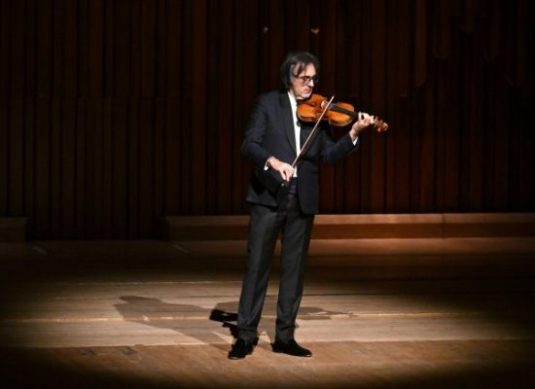 United Kingdom JS Bach: Leonidas Kavakos (violin). Barbican Hall, London, 2 and 3.5.2024. (CSa)
United Kingdom JS Bach: Leonidas Kavakos (violin). Barbican Hall, London, 2 and 3.5.2024. (CSa)

Part 1 (2.5.2024)
JS Bach – Violin Sonata No.2 in A minor; Violin Partita No.3 in E major; Violin Sonata No.3 in C major
Part 2 (3.5.2024)
JS Bach – Violin Sonata No.1 in G minor; Violin Partita No.1 in B minor; Violin Partita No.2 in D minor
Bach’s autographed manuscript of his set of Six Unaccompanied Violin Sonatas and Partitas, commenced shortly after the death of his first wife in 1720, is inscribed with the Italian words Sei solo. Bach, who loved linguistic as well as musical puzzles, chose – perhaps deliberately – an ambiguous title capable of two meanings: ‘six solos’ or ‘you are alone’. This set of works for a single violin, by virtue of its intellectual rigour and instrumental economy can induce a sense of solitary introspection in the listener and make one feel a little lonely. Yet, despite the austerity of materials employed, Bach seeks to communicate a vast universe of emotions filled with love, grief, consolation, dance, sadness and joy. Certainly, the legendary violinist Leonidas Kavakos cut an isolated and somewhat exposed figure as he stood under a single spotlight on the bare Barbican Hall stage, ‘Willemotte’ Strad c.1735 in hand.
Putting to one side the immense technical and physical challenges required, the greatest challenge faced by any performer is to open up an essentially private conversation and communicate the introspective qualities of these compositions to every member of the audience. In a technically superlative performance spread over two evenings, the indefatigable and unerringly modest Kavakos established a singular connection with everyone in the hall which, remarkably, included a large number of children and teenagers – and held them spellbound throughout.
Kavakos started Part 1 of his recital with Sonata No.2 in A minor. The sonata’s stately and declarative first movement Grave was beautifully phrased and minimally adorned. A playful Fuga followed, seamlessly transitioning into a gently pulsating Andante and ending with an Allegro of exceptional clarity. In a change of order from the published programme. Partita No.3 in E major came next. Chockful of rhythmic, elegant dances, it included a richly toned Lure, two lively Menuets, a delicately decorated Gavotte en rondeau and an intensely joyful Bourrée and Gigue.
The second half of the evening was devoted to Violin Sonata No.3 in C major, each movement skilfully shaped and nuanced, and culminating in a stunningly expressive Allegro assai. A standing ovation was rewarded with an encore, a bold and resonant account of the Tempo di Borea from the Partita No.1 in B minor.
The next night’s concert proved to be yet another captivating demonstration of this selfless artist’s skills. Beginning with Sonata No.1 in G minor, Kavakos alternated the tensions of the solemn Adagio with moments of relaxation, while the intricacies of the final movement Presto were dispatched in a blaze of virtuosic wizardry. Turning once again to the Partita 1 in B minor from which the previous evening’s encore had been selected, Kavakos gave us a heartbreakingly tender Sarabande, and an enthralling fourth movement Double (Presto) – a display of pyrotechnic precision and speed which ignited a spontaneous ripple of applause.
After the interval came the final work in the set: Violin Partita No.2 in D minor, which surely represents the pinnacle of these mountainous six solo works. Kavakos played with rare intensity, his flawless technique making light of the work’s complex runs, arpeggios and triple stops. He brought tenderness and warmth to the opening Allemande, perfect balance and control to the foot-tapping Corrente, a luxuriant serenity to the third movement Sarabanda and an irrepressible ebullience to the Giga. The concluding Ciaccona, which stretched for over 16 minutes, was an exquisitely rendered and deeply moving experience. Without losing sight of the overall drama of this movement, Kavakos invested each phrase with subtle shading, so that even the smallest tonal inflections impacted on and enhanced the whole. As the final note resounded and then slowly melted away, Kavakos paused, bow aloft, and stood still for almost a minute, while every member of the audience, from the youngest to the oldest, alone and yet emotionally connected by a transcendent musical event, sat mesmerised in contemplative silence.
Chris Sallon
